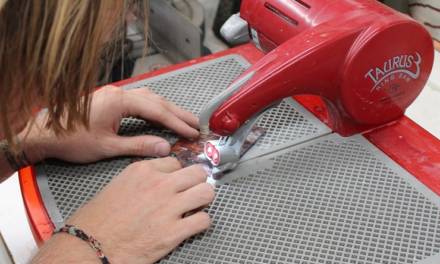The glass cutter is essential to a stained glass artist and it is essential to maintain your glass cutter to ensure smooth clean cuts on the glass. A glass cutter consists of a handle and a beveled cutting wheel. The wheel can be steel or tungsten carbide and rotates freely on an axis and is usually constantly lubricated with a special oil to ensure smooth rotations.
types of Cutting Wheels
Steel Wheels
Steel Wheels tend to be less expensive, but usually don’t last very long. The steel wheel will eventually dull after repetitive use and must be replaced if it does indeed become too dull to make clean scores into the glass.
Steel wheels are good for general purpose or softer glass. The size of the wheel and angle of the bevel on the wheel will determine how hard of a glass it can score.
Tungsten Carbide Wheels
Tungsten Carbide Wheels are more expensive than the steel wheels but their durability is far superior to steel cutting wheels. Their durability tends to outweigh the cost difference since you will usually be replacing steel cutting wheels much more frequently than Tungsten wheels.
Many are self-lubricating which very convenient. Tungsten being much harder than steel are all versatile in handling both soft and hard glass you may encounter in the art of stained glass.
General Maintenance for Glass Cutters
Glass cutter maintenance is very straight forward and easy to follow. When not being used, store in a jar partially filled with a lubricant that covers the bottom of the jar and the wheel. It’s a good idea to pad the bottom of the jar with a piece of cloth or paper towel. Storing it in this oil will reduce any risk of oxidation and ensure your glass cutter lasts for a long time.
Glass lubricant is an oil that is usually a mixture of kerosene and light oil. The lubricant cleans off both dirt and little slivers of glass that tend to cling to the wheel. These slivers of glass can interfere with the rotation of the wheel. Another advantage of the lubricant is that it helps prevent score lines from sealing.
Aside from storing the glass cutter in oil when not in use, if your particular model is equipped with an oil reservoir or “self-lubricating”, always be sure to keep the reservoir filled with oil to keep the glass cutter lubricated throughout the use of the tool. This simple maintenance will help extend the life of the cutting wheel.
Proper Use & Tips
When you score stained glass, don’t go over score lines as this will dull the wheel. Always dip the wheel in lubricant before each score if it is not self-lubricating. Running your wheel off the edge of the glass will also shorten its life. Stop your score 1/8″ from the glass edge, this shouldn’t affect the break and will extend the life of your cutting wheel.
Signs of Trouble with Cutters
If you have to use excessive pressure (over 15 lbs of force) the cutting wheel may be dull and needs replacing. If your score lines look more like a dotted line, this is another inherent sign of an issue and possibly an indication of a cutting wheel that may be dented and again should be replaced.
That is all there is to it and with both proper care and maintenance this tool will serve you well for a long time!











